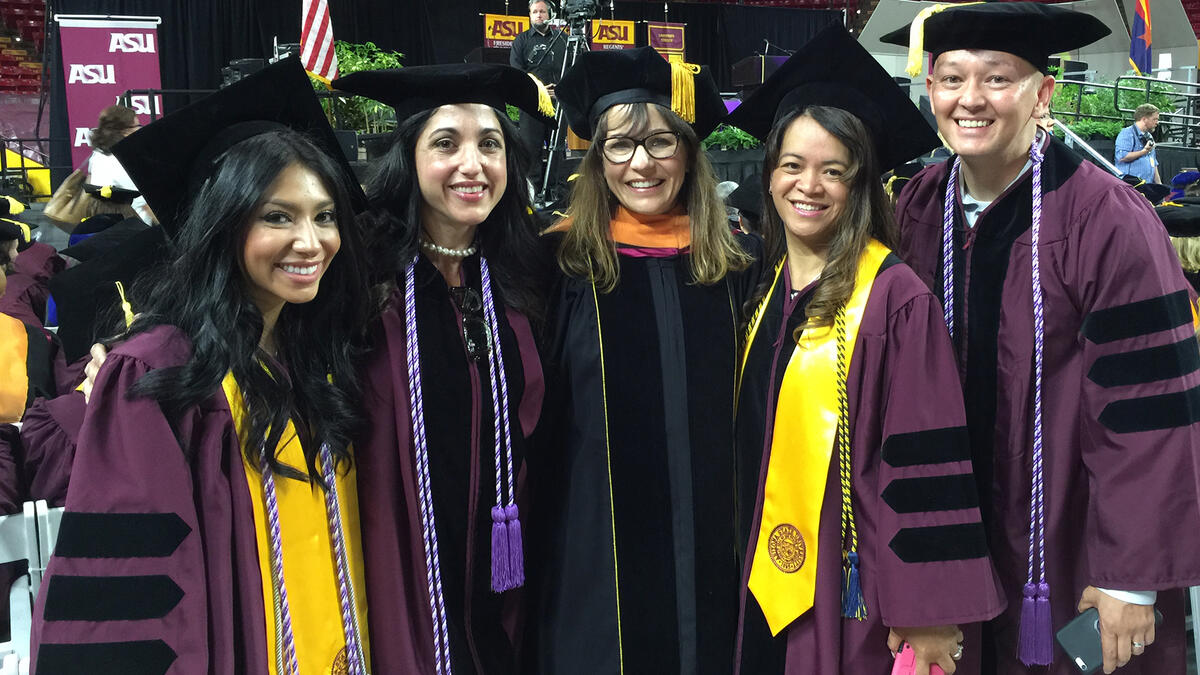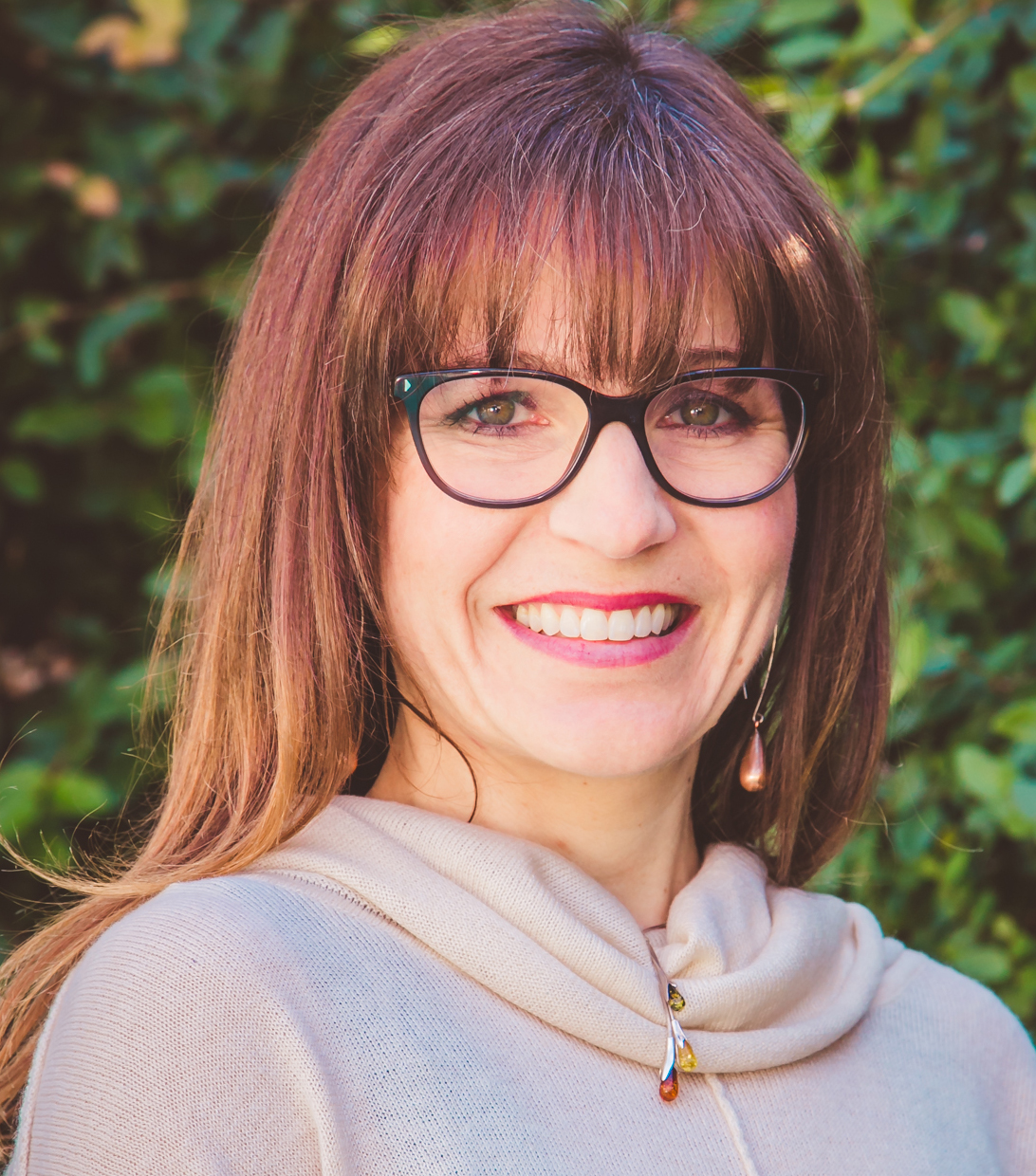Editor's note: This is part of a series of profiles for spring 2016 commencement. See the rest here.
Heather Ross will be the center of a flurry of hoodingHooding at graduation recognizes success in completing a doctoral degree. The graduate has the ceremonial hood placed over the head by a faculty mentor. activity at the Arizona State University Graduate Commencement on May 9. As she receives her second doctorateRoss earned a DNP from the ASU nursing college in 2010 and joined their faculty as a clinical instructor., a PhD from ASU’s School for the Future of Innovation in Society, Ross will then hood four students she mentored, each graduating with their Doctorate of Nursing Practice (DNP) from the College of Nursing and Health Innovation.
With rapid changes in the field of health care presenting a challenge for nurses in particular, Ross seeks ways to integrate clinical, social and psychological perspectives into health care. Her research interests include implanted and wearable medical devices, person-centered care, biomedical technology innovation, and interdisciplinary teamwork in health care.
Ross (left) answered a few questions about ways to empower patients and how a second doctorate has advanced her knowledge.
Question: Why did you choose ASU for your doctoral education?
Answer: Although I was born and raised in Scottsdale, Arizona, I left for New England and the mid-AtlanticRoss received a bachelor’s degree at Yale and a master’s in nursing at Boston College. for 12 years and didn’t plan on returning. However, my husband joined a cardiology group in Arizona. I knew ASU had a strong nursing program, and I decided to take my nursing practice to a doctoral degree.
When I decided to get a PhD, I knew it had to be a field outside of nursing in order to answer the questions I had about policy and interdisciplinary research approaches. I really looked around at online PhDs or a program that I could commute to. Then I discovered that the Human and Social Dimensions of Science and Technology program was sitting here already at ASU and was exactly what I was looking for.
Q: What did you learn from your second doctoral degree?
A: Delivering health care and new health-care technologies are much more complex than our clinical experience alone allows us to examine. I want to be a bridge of communication so that people can connect fields of inquiry.
I learned to look at problems from multiple lenses — as a sociologist, as an anthropologist, an historian and as an economist. And I’m not saying that I became an expert in any one of those fields, but I learned to use those lenses to my advantage. You can’t bang on every question with the same hammer. So all of a sudden I had a whole bunch more hammers that I can use that look at the same problem from another perspective and get a really rich array of solutions.
My PhD has absolutely impacted my clinical practice in the way that I deliver health care and the way that I think about patients and their care.
For example, I did a study where patients used an app to monitor their own heart rhythm, and we found that patients did a really good job with that. Although the monitoring itself wasn’t burdensome and didn’t negatively impact their life, it didn’t actually improve on it either. We need to empower patients to act on monitored data.
Q: Is this why people wear Fitbits or other devices to track their progress?
A: Yes! A patient would never wear one if they didn’t have access to the data. One thing my research has shown is that simply monitoring and collecting data on patients does not empower them to act on the data and doesn’t provide the motivation to make lifestyle changes or improve their quality of life. As health-care providers we need to reframe our thinking. The patient is a member of the health-care team. We must act with patients, not on patients.
Q: What advice would you give someone going into the health-care field?
A: That it is incredibly complex. The policy context and the regulatory context for health-care delivery are in a state of incredible flux and transition right now. There is so much opportunity for creative thinking. For somebody who wants to become a health-care provider now, I would say that it’s no longer enough to just be good at taking care of patients. One has to be prepared to be a policy advocate and to manage complex systems and to be ready to embrace new technology. It’s exciting and challenging and it’s hard work, but there is no greater privilege than being allowed into someone’s life to help navigate the path to their best health.
Q: If someone gave you $40 million to solve one problem on our planet, what would it be?
A: Forty million is not nearly enough to solve the problem of 21st-century education and living skills, but that is where I would put the money. Here’s why: In order to navigate the world, people need to be able to think in flexible ways. Our old way of education in basic subjects is no longer sufficient. The people who are going to be successful contributors to the world community are educated people who think in flexible ways.
I have been so inspired by my students. In the four years I’ve spent getting my PhD, this is the third group of students that I have hooded. It’s been such a privilege to be with these students and I am so inspired by their passion for the work that they do and the scholarly work that they have undertaken. (Some of her students have been involved in Project Honeybee, an experiment in testing wearable biosensors for clinical use before more expensive and invasive procedures become necessary.)
Q: If you have any spare time, how do you spend it?
A: I have three wonderful children who challenge me all the time, and I wish I had more time to spend with them. On the rare occasions when I have spare time, I enjoy watching people who are expert and passionate about what they do, whether it’s acting, stand-up comedy or concerts with really passionate performers. I enjoy people engaged in their bliss.
Written by Michelle St George. Top photo: Heather Ross (center) with her DNP students at the spring 2015 Commencement. Photos courtesy of Heather Ross
More Health and medicine

Reducing waste in medical settings
Health care saves lives, but at what cost? Current health care practices might be creating a large carbon footprint, according to ASU Online student Dr. Michele Domico, who says a healthier…

ASU offers bilingual counseling to Spanish speakers
Arizona is one of the five states in the nation with the highest percentage of Hispanic residents, according to the U.S. Department of Health and Human Services Office of Minority Health, and …

College of Health Solutions launches first-of-its-kind diagnostics industry partnership to train the workforce of tomorrow
From 2007 to 2022, cytotechnology certification examinees diminished from 246 to 109 per year. With only 19 programs in the United States, the cytology workforce that stands at the front line of…



